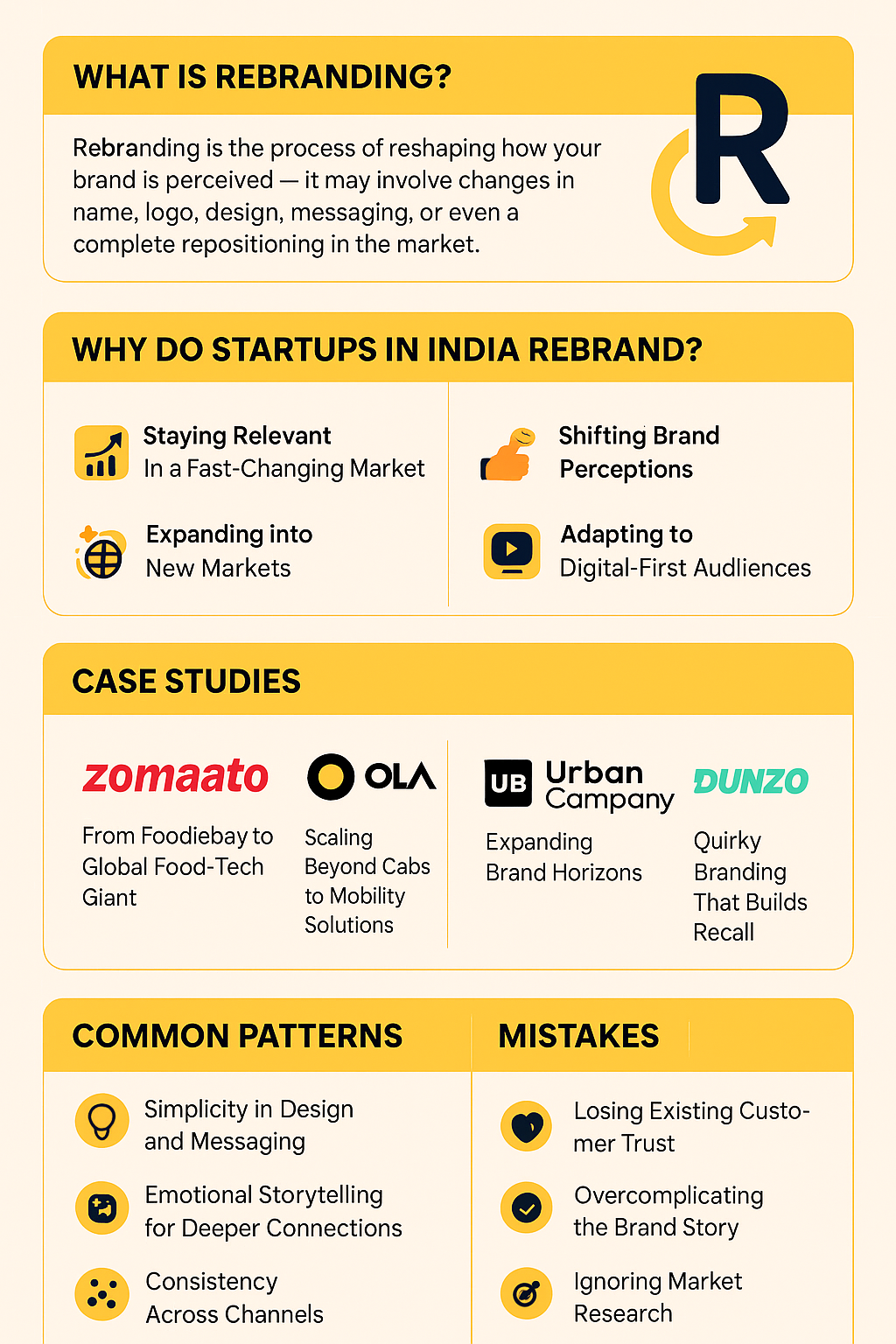Rebranding is more than a logo change—it’s a strategic overhaul that can redefine a company’s identity, market position, and customer perception. In India, several startups have successfully navigated the rebranding journey, offering valuable insights for digital marketers, branding professionals, and business owners.
In this blog, we explore rebranding lessons from top Indian startups, analyze their strategies, and share actionable insights for entrepreneurs and marketers.
🔄 What Is Rebranding? A Simple Definition
Re-branding is the process of reshaping how your brand is perceived. It may involve changes in name, logo, design, or messaging. Sometimes, it even requires a complete repositioning in the market. Unlike just redesigning a logo, re-branding touches the very core identity of a business.
🌟 Why Do Startups in India Re-brand?
Staying Relevant in a Fast-Changing Market
Consumer behaviors evolve rapidly, especially with India’s digital-first generation. Rebranding helps startups adapt.
Shifting Brand Perceptions
A fresh identity can shift public perception, like from a local player to a global disruptor.
Expanding into New Markets
When entering new geographies or verticals, rebranding helps build broader appeal.
Adapting to Digital-First Audiences
Today’s audiences engage across social media, apps, and websites. Rebranding aligns visuals and tone with digital needs.
Case Studies: Indian Startups That Re-branded Successfully
Zomato: From Foodiebay to Global Food-Tech Giant
- Originally named Foodiebay, Zomato rebranded to a sleek, global-friendly name.
- Lesson: Choose a name that scales internationally.
Ola: Scaling Beyond Cabs to Mobility Solutions
- From being “OlaCabs,” the brand rebranded as Ola, signaling its move into bikes, EVs, and beyond.
- Lesson: Keep names short and flexible for growth.
Urban Clap to Urban Company: Expanding Brand Horizons
- UrbanClap rebranded to Urban Company to reflect its broader service marketplace vision.
- Lesson: Remove niche limitations from your name.
Dunzo: Quirky Branding That Builds Recall
- Dunzo leaned on humor, vibrant colors, and youthful tone, becoming a cultural brand in urban India.
- Lesson: Emotional connect beats plain functionality.
Paytm: Strengthening Identity Amidst Fintech Growth
- Paytm’s rebranding efforts have been about trust and security as fintech regulations evolved.
- Lesson: Use branding to reinforce credibility.
Common Patterns in Successful Rebrands
Simplicity in Design and Messaging
Clean visuals and easy-to-understand messaging resonate more.
Emotional Storytelling for Deeper Connections
Brands that tap into culture and values create stronger bonds.
Consistency Across Channels
Logos, ads, and customer experience must align.
Customer-Centric Approach
Successful rebrands put customer needs at the center of identity.
Mistakes Startups Should Avoid While Rebranding
- Losing Existing Customer Trust: Keep familiarity intact.
- Overcomplicating the Brand Story: Too much change confuses audiences.
- Ignoring Market Research: Assumptions lead to failures.
- Lack of Internal Alignment: Employees must believe in the new identity first.
Actionable Lessons for Startups Planning a Re-brand
- Do deep research before redesigning.
- Test with small audiences first.
- Keep the core identity intact.
- Align branding with long-term vision, not short-term trends.
Sponsored Section: Recommended Reads for Startup Branding
Building a StoryBrand 2.0 : Clarify Your Message So Customers Will Listen : Donald miller
FAQs on Startup Rebranding
Q1. When should a startup consider rebranding?
When entering new markets, facing declining relevance, or scaling beyond its original vision.
Q2. Does rebranding always mean changing the logo?
No. It can include messaging, positioning, or even tone of voice.
Q3. How long does a rebrand take?
Depending on scope, it can range from 3 months to 1 year.
Q4. What’s the biggest risk in rebranding?
Losing customer trust if changes feel disconnected from the core brand.
Q5. Is rebranding costly?
It depends — but poor rebranding costs more in lost customers than strategic investment.
Q6. Can startups rebrand multiple times?
Yes, but frequent changes may confuse audiences.
Conclusion: Rebranding as a Growth Catalyst
The success stories of Zomato, Ola, Urban Company, Dunzo, and Paytm show that rebranding, when done right, is not just cosmetic but transformational. For Indian startups, it’s a growth catalyst — helping them expand, connect emotionally, and stay future-ready.
As a founder or marketer, remember: Rebranding should preserve trust while unlocking new opportunities.
